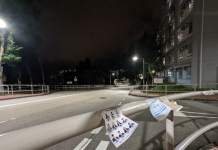Traditional paper-craft finds new groove
By Jane Leung, Lily Yu & Sam Kwong



















Au Yeung Ping-chi sits quietly in the 55-year-old paper crafting shop he inherited from his father and carefully puts together a frame made of bamboo splints, comparing it to a cartoon monkey he had sketched on a piece of paper earlier. A customer has asked him to make the paper monkey, based on the appearance of a stuffed toy, as an offering for a dead relative.
Paper crafting is a technique involving the use of bamboo splints, pieces of coloured paper, rice paper strips, silk fabrics and adhesive paste. The craftsperson first builds a basic structure, attaches paper to the frame, adds colours and assembles separate parts of the piece. The burning of joss paper and paper effigies as offerings to the deities and the dead at funerals and festivals is an ancient Chinese practice. People in Hong Kong relied on paper craft supplies from Guangdong until the first local paper crafting shops opened here in the 1940s.
As a second-generation paper-crafter, 39-year-old Au Yeung Ping-chi has been incorporating new elements in his paper offerings. His father has been supportive and grants him a lot of freedom to apply his modern sensibilities and creativity to the traditional craft.
In his father’s day, clients asked for paper cars, houses and servants to enrich the afterlives of their ancestors. In recent years, the requests have been more diverse – for instance, customers have asked Au Yeung to make a set of ski equipment, a slot machine and a bowl of rice noodles with chicken wings.
Unlike in the past, and in a break with taboos surrounding death, Au Yeung has sometimes been instructed to make paper crafts as decorative objects for the homes of the living. “A young man once asked me to make a paper camera that holds his business cards…and a paper radio for another customer as well,” Au Yeung says.
A crucial difference between paper crafts that are used as offerings and those for decorative purposes is that the latter are usually made with iron wires instead of bamboo, as they do not need to be burnt.
“Most people are still under the impression that the paper crafting industry is all about burning paper cars, houses and ships for the dead at the funeral homes,” says Mo Cheuk-kei, 45, who is also a paper craftsman. He points out that apart from funerals, paper crafts also feature prominently in nearly all religious and festive occasions in the Chinese calendar, especially the Hungry Ghost Festival, Mid-Autumn Festival and Lantern Festival. The Hong Kong Traditional Paper Crafting Arts Union, which Mo chairs, runs classes teaching students to make decorative lanterns that are in high demand at these festivals. With some modifications to the original designs, these creations can be used as ceiling lamps, table lamps or wall lamps at home.
Hong Kong’s paper crafting industry enjoyed its heyday in the 1960s thanks to an influx of seasoned craftsmen arriving from the Mainland. But with the opening up and economic reform of China in the 1980s, many local paper crafting stores moved production to the Mainland. Since then, the Hong Kong market has been dominated by cheap, low-quality paper crafts made across the border while the domestic industry continues to shrink. Unofficial estimates put the number of paper craftsmen in Hong Kong at less than 50. Only three or four crafters are “professional”, in the sense that they are capable of creating a paper craft from start to finish.
In an attempt to help preserve traditions with high cultural value, the government compiled the first Representative List of the Intangible Cultural Heritage of Hong Kong in 2017, and the paper crafting technique is one of the items on the list.
Hui Ka-hung, 38, taught himself how to craft the heads of lions used in lion dances at the age of 11. He later founded his own brand Hung C Lau Ltd. and says his business has benefited from the exposure brought about by the listing. “Paper crafting has attracted more media coverage and more people have paid attention to it as a local product…we are given more opportunities,” he says.
Hui thinks innovation is the key for the long-term development of paper crafting as an industry. “I am eager to do creative things, because paper crafting should not be confined to being a traditional, old-school technique…I want to transform it into an art.”
With this end in mind, Hui has partnered with local artists and designers to create large installations. In one of his latest projects, he used traditional paper crafting skills to turn a street-art style lion head by a Thai designer into a three-dimensional piece which was displayed in a shopping complex in Causeway Bay.
While traditional paper crafters are turning to innovative ideas, a number of self-taught amateurs are also contributing to the craft’s ongoing evolution. Wong Lit-kei specialises in crafting paper qilins. A few years ago, he experimented with making these Chinese mythical creatures and put one on display in his mother’s incense shop in Cheung Chau. Neighbours began asking him to make them to display as decorations in the home.
“Some even fill their beds up with these mini qilins, or put them up onto the wall; I didn’t know they would like them that much,” Wong says. To his surprise, he even received orders from tourists from Taiwan, Singapore, Britain and Australia.
Despite reminders from his elders, 33-year-old Wong does not perform traditional rituals to scare the “spirits” of the qilins off before crafting them. Not sharing the taboos associated with either qilins or paper crafting, Wong and his customers are at ease with keeping them at home as decorations or feng shui devices. Occasionally, Wong is also asked to custom-make paper crafts of other things, such as a fox head for display in a boutique.
Another amateur craftsman Cheng Siu-Mo, 35, made his first lantern from a pre-made pack eight years ago. Then, without any formal training, Cheng developed his own method for making cartoon lanterns with rattan splints. Through trial and error, he has developed new products that differ from traditional paper crafts.
“Conceptually it might a paper craft, but it turns out to be more than that – a decorative figure that has different uses,” Cheng says as he explains how his creations can be used as lamps, displayed as figures or given as gifts.
Eventually, he was inspired to learn traditional paper crafting techniques and apply these to his works. He believes the two styles, old and new, can complement each other.
Edited by Elaine Ng








































